Mahakam River
The Mahakam River (Indonesian: Sungai Mahakam) is a river in Kalimantan, Indonesia. It flows 980 km from the district of Long Apari in the highlands of Borneo, to its mouth at the Makassar Strait.
| Mahakam | |
|---|---|
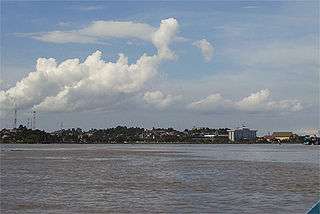 Mahakam River at Samarinda | |
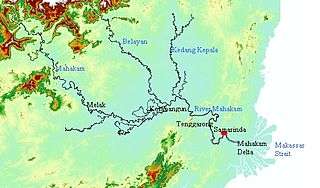 | |
| Location | |
| Country | Indonesia |
| Province | East Kalimantan |
| Towns/Cities | Samarinda, Tenggarong, Sebulu, Muara Kaman, Kotabangun, Melak, Long Iram |
| Physical characteristics | |
| Source | Cemaru |
| • location | Indonesia |
| • elevation | 1,681 m (5,515 ft) |
| Mouth | Mahakam Delta, Makassar Strait |
• location | Mahakam Delta, Sungai Mariam, Indonesia |
• elevation | 0 m (0 ft) |
| Length | 980 km (610 mi) |
| Basin size | 77,100 km2 (29,800 sq mi) |
| Discharge | |
| • location | Melak[1] |
| • average | 2,500 m3/s (88,000 cu ft/s) |
| • maximum | 3,250 m3/s (115,000 cu ft/s) |
| Basin features | |
| Tributaries | |
| • left | Kedang Pahu |
| • right | Kedang Rantau, Kedang Kepala, Belayan |
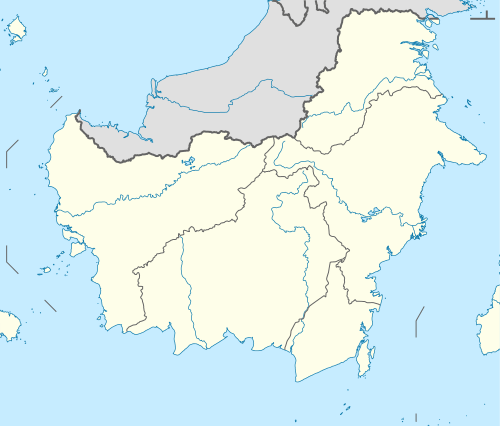
The city of Samarinda, the provincial capital of East Kalimantan, lies along the river 48 km (30 mi) from the river mouth. The delta Mahakam river consist of specific micro climate which is influenced by high and low tide at sea level.
Summary
The Mahakam River is the largest river in East Kalimantan, Indonesia, with a catchment area of approximately 77,100 km2. The catchment lies between 2˚N to 1˚S latitude and 113˚E to 118˚E longitude. The river originates in Cemaru[2] from where it flows south-eastwards, meeting the River Kedang Pahu at the city of Muara Pahu. From there, the river flows eastward through the Mahakam lakes region, which is a flat tropical lowland area surrounded by peat land. Thirty shallow lakes are situated in this area, which are connected to the Mahakam through small channels . Downstream of the connection with the Semayang and Melintang lakes, the Mahakam meets three other main tributaries - the rivers Belayan, Kedang Kepala, and Kedang Rantau - and flows south-eastwards through the Mahakam delta distributaries, to the Makassar Strait.
Geology
Kalimantan, where the Mahakam lies, is part of the Sunda Continental Plate. The large island has mountain ranges between Indonesia and Malaysia. As described by van Bemmelen (1949), River Mahakam rises in Cemaru (1,681 m) in the centre of Kalimantan, from there it cuts through the pre-tertiary axis of the island east of the Batuayan (1,652 m) and then reaches the tertiary basin of Kutai.[3] Its middle course traverses a lowland plain with many marshy lakes. This intermontane depression is separated from the neighboring basin, the Barito depression, by a broad hilly tract of less than 500 metres (1,600 ft) altitude. After this region, the Mahakam cuts through the Samarinda anticlinorium and reaches its alluvial delta, which spreads like a broad fan over the shelf-sea, with a base of 65 kilometres (40 mi) and a radius of about 30 kilometres (19 mi).[4]
Upstream of Long Iram (upstream part of Mahakam river basin) the river is flowing in tertiary rocks (Voss, 1983).[5] Between Long Iram and Muara Kaman (middle Mahakam area) the river is flowing in quaternary alluvium, while in the downstream area between Muara Kaman and the coast including the Mahakam delta, tertiary rocks are again present. The presence of the large delta is explained by the formation and rejuvenation of the hilly region near Samarinda.[6]
Climate
The Mahakam catchment is around the equator. According to Köppen climate classification, this area belongs to type Af (tropical rainforest) that has a minimum temperature ≥18 °C and precipitation of the driest month in normal year ≥60 mm[7] Transfer of mass and energy in the tropical zone occurred through general air circulation known as the Hadley cell. According to Seidel et al. (2008) the precipitation pattern in this area is largely determined by this large-scale atmospheric wind patterns, which is observable in several ways throughout the atmosphere. This circulation carries moisture into the air, generating rainfall in equatorial regions, whereas at the edges of the tropical belt are drier.[8] Within this circulation, evaporation occurs intensively around the equator on the centre of low pressure called the Intertropical Convergence Zone (ITCZ), characterized by accumulation of cloud in the area. The ITCZ moves following the pseudo-motion of the sun within 23.5°N and 23.5°S zone, therefore its position always changes according to this motion.
The ITCZ drives the Indo-Australian monsoon phenomena which influence the regional climate including the Mahakam catchment. In December, January, February (winter in Northern Hemisphere) the concentration of high pressure in Asia and low pressure in Australia make the west wind blows in Indonesia (west monsoon). In June, July, August concentration of low pressure in Asia (summer in Northern Hemisphere) and concentration of high pressure in Australia make the east wind blows in Indonesia (east monsoon). Due to the global air circulation and the regional climate mentioned above, the Mahakam catchment which is located around the equator has a bimodal rainfall pattern with two peaks of rainfall, which are generally occurred in December and May. This is because the ITCZ passed through the equator twice a year, from the Northern Hemisphere in September and from the Southern Hemisphere in March.[9]
Lakes
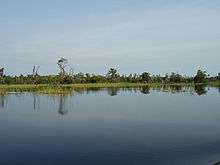
There are about 76 lakes spread in the Mahakam river basin and about 30 lakes are located in the middle Mahakam area including the three main lakes (Lake Jempang 15,000 Ha; Lake Semayang 13,000 Ha; Lake Melintang 11,000 Ha).[10] The lakes levels are seasonally fluctuated from 0.5 m – 1 m during dry period to seven meters during rainy season. The Mahakam lakes and surrounding wetlands act as water storage as well as a trap of sediment contained in the water flowing into the lakes which are now known to become shallower, presumably as a result of an imbalance between sediment input and slow subsidence.
Fishing is the primary source of livelihood in the Mahakam lakes area, most of the people around the lakes are fishermen. The middle Mahakam lake area is an area of intensive fishing activity with a productivity of 25,000 to 35,000 metric tons per year since 1970.
Delta
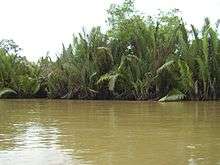
The Mahakam delta is a mixed fluvial-tidal dominated delta. The delta covers about 1800 km2, consisting of mangrove areas near the shore, Nypa swamps in the central areas, and lowland forest near the apex, corresponding to the first bifurcation, however, recent fishery development in this area has converted a vast area of mangrove into shrimp ponds (tambak). The delta has three main distributaries system directed Northeast, Southeast and South. The area between distributaries consists of a series of tidal channels generally unconnected to the main distributaries.[11] The distributary channels are narrow and rectilinear with the depth ranging from 8 to 15 m and distributary channel bifurcations appear every 10 to 15 km.[12]
This lower Mahakam area is the second most productive hydrocarbon basin of Indonesia which contains around 3 billion barrels of oil and 30 Tcf of gas reserves.[13] Field geological investigations in this area was started in 1888 and in 1897 exploration drilling discovered oil at shallow depth of 46 m on the Louise structure. Production started in 1898 followed by expansion of exploration to the entire Mahakam.[14]
Ecology
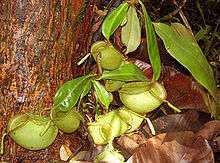
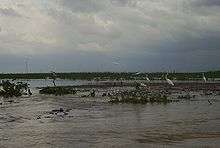
Mahakam and its floodplain is an ecologically important region. A total of 147 indigenous freshwater fish species had been identified from the Mahakam.[15] The Mahakam hosts the freshwater dolphin Irrawaddy dolphin (Orcaella brevirostris; called Pesut by local people) a critically endangered species, which is included on CITES (Convention on International Trade in Endangered Species of Wild Fauna and Flora) Appendix I. The Mahakam river basin is also an important breeding and resting place for 298 bird species, among them 70 protected and five endemic species: Borneo dusky mannikin (Lonchura fuscans), Borneo whistler (Pachycephala hypoxantha), Bornean peacock-pheasant (Polyplectron schleiermacheri), Bornean blue-flycatcher (Cyornis superbus) and Bornean bristlehead (Pityriasis gymnocephala).
A research cluster (): "Upsetting the balance in the Mahakam Delta: past, present and future impacts of sea level rise, climate change, upstream controls and human intervention on sediment and mangrove dynamics" extensively carry out research on the Mahakam. The cluster's objective is to study the impact of external forcing factors such as sea-level rise, climate change, upstream sediment, as well as human interference on past, present and future development of the Mahakam delta in different time scales.
Pollution
Logging and mining activities have contributed to the "alarming rate" of pollution of East Kalimantan's Mahakam River. Tests of water pollutants showed levels increased sharply between 2009 and 2011. Despite the growing pollution, it is claimed that "the water is basically still safe for consumption."[16]
Unsafe concentrations of heavy metals have been observed in Mahakam fish. A 2015 study found lead concentrations in excess of 1000 times safe levels along with unsafe levels of copper, zinc, and cadmium.[17]
Bridges
Bridges include the 400 m Mahakam Bridge and the 710 m Kutai Kartanegara Bridge. The latter collapsed on 2011-11-26, it took 3 years of planning and one and half years more to rebuild new bridge on the same spot. The new Kutai Kertanegara Bridge now open for public since 2015-12-08 after opening ceremony held by local regent.
Social aspect
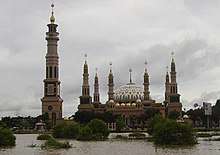
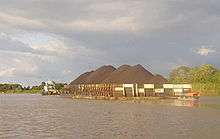
The River Mahakam is an economic resource for fishermen and farmers, and as freshwater source, as a waterway since ancient time until today. It is in this river basin where the Kutai kingdom evolved. The Kutai history is divided into two periods, Kutai Martadipura (around 350-400) and Kutai Kartanegara period (around 1300). Kutai Martadipura, a Hindu kingdom founded by Mulawarman at Muara Kaman, is regarded as the oldest kingdom in Indonesia.[18] Kutai Kartanegara was founded by settlers from Java at Kutai Lama near the mouth of Mahakam. In around 1565, Islam was extensively spread in Kartanegara by two Moslem preachers from Java, Tunggang Parangan and Ri Bandang.[19]
The Dayaks are the indigenous people inhabiting Kalimantan beside the Kutais and the Banjars. Since the 1970s transmigration of people to East Kalimantan was organised by the Indonesian government especially in areas near River Mahakam. Transmigration aims to migrate people from overpopulated Java, Bali, and Madura islands to stimulate greater agricultural productivity in outer islands. By 1973, almost 26% of the land under cultivation in East Kalimantan was being worked by transmigrants.[20]
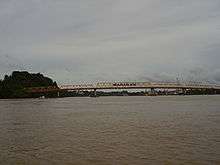
References
- Hidayat et al., 2011. Discharge estimation in a backwater affected meandering river, HESS, 15, 2717-2728, 2011.
- van Bemmelen,R.W., 1949. The Geology of Indonesia.
- van Bemmelen,R.W., 1949. The Geology of Indonesia.
- van Bemmelen,R.W., 1949. The Geology of Indonesia.
- Voss, F.: Kalimantan Timur, Atlas. HWWA Institute, Hamburg, 1983.
- IWT Kalimantan, Contribution Delft Hydraulics, Appendix I Mahakam River
- Peel, M.C., B. L. Finlayson, and T. A. McMahon, 2007. Updated world map of the Koppen-Geiger climate classification. Hydrol. Earth Syst. Sci., 11, 1633–1644.
- Seidel, D.J., Qiang Fu, William J. Randel & Thomas J. Reichler, 2008. Widening of the tropical belt in a changing climateNature Geoscience 1, 21 - 24, Published online: 2 December 2007, doi:10.1038/ngeo.2007.38
- Hidayat, 2013. Runoff, discharge and flood occurrence in a poorly gauged basin – The Mahakam River, PhD thesis, Wageningen University
- East Kalimantan provincial government, 2002. Master Plan Sungai Mahakam. Dinas Pekerjaan Umum dan Pemukiman Prasarana Wilayah (in Indonesian)
- Wiweko A., 2002. The modern Mahakam delta in Modern, ancient deltaic deposits and petroleum system of Mahakam area, Totalfinaelf E&P Indonesie.
- Allen, G.P., Chambers J.L.C., 1998. Sedimentation in the modern and Miocene Mahakam Delta. Indonesian Petroleum Association
- Mora S., Ten Haven L., 2002. Petroleum system of lower Kutai basin in Modern, ancient deltaic deposits and petroleum system of Mahakam area, Totalfinaelf E&P Indonesie.
- Homewood P, Roy D., 2002. A historical perspective on the exploration of the Mahakam in Modern, ancient deltaic deposits and petroleum system of Mahakam area, Totalfinaelf E&P Indonesie.
- Christensen, M.S., 1992. Investigations on the Ecology and Fish Fauna of the Mahakam River in East Kalimantan (Borneo), Indonesia. Int. Revue ges. Hydrobiol., 77(4).
- Mattangkilang, Tunggadewa. "Pollution of Mahakam River Has Reached 'Severe' Levels: Environment Agency". Jakarta Globe. Retrieved 8 October 2015.
- Adri, N (13 April 2015). "Fish in Mahakam River delta contaminated by heavy metals". Jakarta Post. Retrieved 8 October 2015.
- "Archived copy". Archived from the original on 2011-08-21. Retrieved 2009-12-24.CS1 maint: archived copy as title (link)
- Allan J. & Muller K., 1988. The Times Travel Library: East Kalimantan, Ed. By P. Zach, Times Editions.
- Babcock, 1986 as cited by Stadtmueller T., 1990. Soil erosion in East Kalimantan, Indonesia. Proceedings of the Fiji Symposium Research Needs and Applications to Reduce Erosion and Sedimentation in Tropical Steeplands, June 1990: IAHS-AISH Publ. No.192,1990.